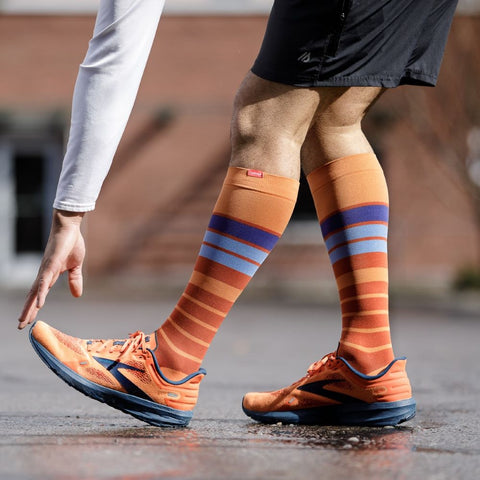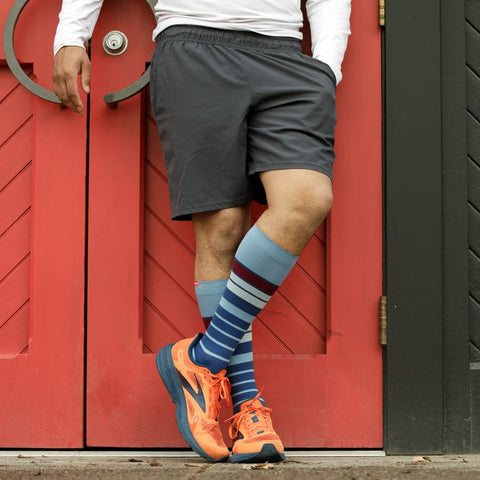A Guide to Compression Socks for Triathletes & Their Benefits
Compression garments, particularly socks and calf sleeves, are well-known for their positive effect on athletes’ recovery. They also provide additional benefits, whether you’re training or racing.
Can compression socks benefit triathletes, and how? Thanks to the way they boost blood flow in the lower legs and support the joints, compression socks and sleeves are good for triathletes’ recovery, performance, and injury prevention.
In this essential guide, we’ll cover:
- How and why you should wear compression socks as a triathlete;
- What are the benefits;
- How to use your triathlon compression socks;
- How to make the best choice for you.

Can Compression Socks Help Triathletes?
Yes, triathletes stand to benefit from wearing compression socks, for recovery, for performance, and for injury prevention. This is because the support and boost in blood flow that these garments provide have been shown to yield benefits for athletes in a wide range of sports.
Firstly, compression socks apply gentle pressure to the lower limbs, which acts as a stimulant for peripheral circulation. Graduated compression socks, in particular, prevent blood from pooling around the ankles, reducing the risk of swelling and pain when you’re on your feet a lot. This is great at the end of a triathlon, when you’re running on tired legs, but also during your recovery from training.
Secondly, the boost in blood flow also acts to reduce the time it takes to recover from hard workouts. Several studies have shown the benefits of compression to refuel and repair sore muscles. This not only helps you feel better after your workouts - it also gives you energy and motivation for your next session (as you’re not so sore anymore!).
This is partly why compression socks have been linked with increased athletic performance. For some, the improved performance is connected with how much athletes believe in the efficacy of compression socks. But, more generally, it’s been demonstrated that compression socks reduce the time it takes to recover. This means you’ll be more rested and more likely to perform better in your next session.
Finally, compression socks play an important role in injury prevention and during the return from injury in sports. The tight grip they have on the ankles and feet provides added stability and support, especially for athletes who’ve suffered a sprain or Achilles’ tendonitis, among others. Through the boost in blood flow, they reduce the risk of swelling, edema, and circulatory problems. Additionally, the support from compression socks reduces the impact of micro vibrations on the muscles, which is particularly relevant for runners.

The Benefits of Compression Socks for Triathletes
The three main ways in which compression socks act on the lower legs (support, boost in blood flow, massage and recovery) all bring important benefits to triathletes. Whether it’s sore legs from running training, cramps on the bike, or numb feet from cold water swimming, here’s how they can address all those issues and more.
Reduced Muscle Fatigue and Soreness
Compression socks massage sore muscles and boost the blood flow into the lower limbs. This helps reduce soreness and fatigue after hard workouts. Increased blood flow brings with it oxygen and nutrients, which help muscles recover quicker, too.
Prevention of Common Leg Issues
Thanks to the grip they have on the lower legs, compression socks also help increase stability and reduce some of the repeated impact of landing on hard surfaces while running. This makes them great for injury prevention, helping reduce the risk of developing shin splints or calf sprains.
Compression socks also tend to stay in place better than regular socks, which helps decrease the risk of rubbing and blisters. This is particularly helpful when you’ve just come out of the water from the swim leg of your triathlon, and the skin can be more vulnerable to rubbing. Some socks provide added support to the arch, to help avoid plantar fasciitis.
Enhanced Recovery After Races and Training
Through improved blood flow in the lower legs and the relaxing massage they provide to sore calves and feet, compression socks have become a go-to recovery tool for triathletes. They help nutrients and oxygen travel to the calf muscles, reducing the time it takes to recover from training or from a race. They also soothe aching, tired limbs, and can reduce inflammation and swelling.
Improved Endurance
Compression socks have long been linked to improved performance and increased endurance in athletic activities. There is no direct scientific evidence of this, but the way they act on the lower limbs can give us some reasons to resort to compression for triathlon training.
The boost in blood flow helps deliver oxygen and nutrients to the muscles on a continual basis. So, if you wear compression socks during a triathlon, you’re not having to wait until after the race to refuel and rebuild damaged muscle tissue - you should be seeing this happen in real time (although the effects will not be instantaneous, of course!). Moreover, compression socks help reduce recovery times, which means that athletes can train better and more often. Over time, this will improve their endurance and their performance.

How to Use Compression Socks for Triathlon Performance and Recovery
Compression socks or calf sleeves are very popular with triathletes for their support, boost in blood flow, and impact on recovery. You can get benefits from using them during training blocks and throughout the racing season, as well as more casually (even for extra style points!).
Using Compression Socks During Training
While training for a triathlon, you’re likely to be doing some type of workout most days of the week, and sometimes even train twice a day. To refresh your legs and help the muscles recover in between sessions, wear compression socks for recovery, after you’ve showered and changed into comfortable clothing (or, if you’re heading straight to work, then wear socks or compression tights with your clothes).
You can also get benefits from wearing compression socks before working out. The increase in blood flow will act like part of your warm-up, as will the extra massage to the muscles. Finally, wearing compression socks or sleeves during your workouts gives you extra support for muscles and joints and helps prevent injuries. Ultimately, you could wear your socks at any point throughout the training season - it’s a matter of personal preference to use them whenever it feels the best for you.
Strategies for Race-Day Usage
There are a few reasons to wear compression socks for your race. However, it’s important that you don’t try anything new on race day: if you haven’t been running or biking in your socks, and just used them for recovery, now is not the time to try them!
While you’re warming up before heading into the water, especially on a cold day or if swimming in open water, putting on compression socks helps warm up the muscles and loosen them (since the heat relaxes tight muscles). This can be very helpful once you start swimming, as it will reduce the risk of cramping from the cold.
Once out of the water and in transition before the bike, it depends how quickly and efficiently you’re trying to move. Shorter triathlons, such as Olympic distance, require athletes to transition quickly, while endurance events like Ironman-distance triathlons are full of slower moving triathletes when they switch from swim to bike and from bike to run. The latter depends, as well, on where you are in the field (the elites will always move a lot faster than the amateurs!).
With that in mind, it’s important to practice with compression socks before the race to see if you’re happy putting them on during transition. Particularly after the swim, you may find that damp skin and potentially cold fingers prove to be serious obstacles to putting on tight compression garments. However, you may find it easier to change into compression socks for your run, after the bike.
Generally, the easiest approach is not to wear compression socks during your triathlon, unless you’ve practiced putting them on during transitions beforehand.

When and How Long to Wear Compression Socks
It only takes minutes for compression socks to make their effects felt. You should immediately feel the added pressure and massage to the lower legs, which gives most triathletes a feeling of relaxation and soothing. This is why you can pretty much put on your socks right after you’ve worked out and showered.
How long you wear compression socks is a matter of personal preference. We recommend starting with a few hours if you’re new to compression, allowing your body to gradually become used to the feeling of added pressure. Then, increase the time you spend with your socks on gradually, removing them when you go to bed.
Choosing Triathlon Compression Socks
Not sure how to find the best pair of compression socks for you? Here are a few essential tips.
Understanding Compression Levels
Compression socks are not all the same, ranging in the level of pressure they apply to the legs. This is measured in mmHg - you’ll usually start at 15-20 mmHg, otherwise known as “everyday” compression that you can wear casually during recovery or while working out.
For those suffering from circulatory problems or when recovering from an injury, your doctor may prescribe firmer compression, at 20-30 mmHg. Finally, 30-40 mmHg are medical grade compression socks that are only available with a prescription and are used to treat specific conditions.
Proper Sizing and Fitting Tips
The key to getting the benefits of compression for triathletes is to wear socks that fit well and are the right size for you. They cannot be too tight, or they will cut off your circulation, while loose-fitting socks simply don’t give you any benefits.
Follow a sizing guide to know what size socks you should buy. Then, put your socks on carefully, ensuring that the heel and toes are nestled well into their respective slots, and that the socks are pulled up to just under your knee. You shouldn’t see any bunching or folding in the material.
Compression Sock Types to Consider
Beyond the usual knee-high compression socks, triathletes can also consider wearing calf sleeves to focus specifically on supporting the calf muscles and/or shins, especially during a run. This also allows you to switch to different socks if you have a particular preference.
Additionally, you could consider wearing open-toe compression socks if you needed to bandage your toes to avoid blisters or to treat a condition. This is probably less comfortable during a triathlon, however.
Style and Material Considerations
Cotton compression socks come in a multitude of styles and colors and can be worn pretty much in any setting. They are our go-to recommendations for recovery socks. But, what if you sweat heavily, have irritable skin, or find cotton to not be breathable enough during triathlon training?
The other two main options are nylon and merino wool socks. Nylon compression socks are thinner and very flexible, moving with your body, which makes them ideal for wearing during exercise. For hotter days or, conversely, if you want to keep your feet warm in cooler temperatures, merino wool is an excellent thermoregulator. We recommend wearing merino wool socks for long runs or bike rides as they are breathable and hypoallergenic, helping prevent any fungi or infections from developing. They also keep feet dry and blister-free.



















Leave a comment